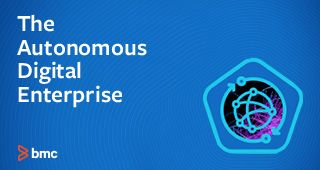Now that we’re well into 2021—and almost to 2022—we’re learning that businesses that thrived during the upheaval of the pandemic did so because they adapted their business processes, or accelerated improvements that were already underway. When I sat in on a CIO roundtable with tech leaders across IT, education, logistics, and the public sector, we discussed IT reinvention and the way it’s changing the role of IT.
First, I define reinvention as an organization shifting responsibilities from the traditional cost and complexity management to those capabilities that address the emerging needs of a business, ultimately enabling every company to become a tech-driven company while simultaneously running the business.
There is also a dual mandate to support both traditional product lines and new digital business units, the formalization of which of varies by industry sector. This has implications on the evolving role of the chief information officer (CIO) and the IT organization to drive the digital mandate or cede that role to a chief digital officer (CDO), which can also vary by organization. The journey is different for everyone. Here are some of the key takeaways from our discussion.
Leading new technology adoption
A global networking CIO is leading her company’s reinvention with software-as-a-service (SaaS) offerings “to become a different kind of operating company” and “customer experience organization.” She explained that she sometimes faces challenges moving the business off the status quo and asks whether leaders are being thoughtful about their business models, “not only in our products but across the business to solve the business challenges.”
“Once something is stable and people have moved on, it’s very hard to let them get them to let go of it and that keeps you bound in a certain set of resources which typically are not the resources you need for the future. It’s often difficult to change that mindset,” she adds.
Another roundtable member is CIO of a cross-threaded business model of U.S. geriatric practices and restaurants that span millions of square feet of real estate. He sees his team’s model as an “intersection between design thinking, lean agile, and visual collaboration…to make sure we understand what problem we’re trying to solve.” He goes on to explain that, “The how should be consistent and the what should always change.”
The CIO of a U.S.-based mining processing and logistics company said his company had been reinventing before the pandemic, but the pandemic shifted the timing and the prioritization of some projects. “I think the biggest thing for us…from an IT perspective [is] a change in mindset and starting to think more like products, as opposed to projects, and that’s really been good for us,” he shared. The company has also worked differently with its end customers, which include truck drivers who are always mobile, and a nationwide supply chain, to get app releases in their hands as quickly as possible.
Serving a remote workforce and community
The IT leader of large U.S. public library system serves 100,000 employees in 34 departments and millions of constituents across a county. The library dispatched staff home to work remotely with tablets and laptops, leveraging Office 365 and undertaking a county-wide risk management framework. “We were able to push all of our processes and operations basically from the scheduler and we’re remotely working pretty effectively,” she says. “I think we have to still continue to think outside the box when we’re pushing a technology to drive where we’re going and then allow the flexibility of it to create a roadmap.”
Capitalizing on success
The CIO of a U.S.-based private university system says reinvention is innately part of its strategy, and that technology itself is essential to literacy in the same way reading and writing are. “We are blurring the lines between CIO and approvals. We work together [and] partner [to] create degree programs and minors and those are initiated by IT. That’s one example of how we are shifting the strategy,” he explained. The organization is also incubating its IT work so it owns its intellectual property, folding customer centricity into its reinvention, and in the process more than tripled its Net Promoter Score.
According to the CIO of an engineering, construction, business consulting, and operational services firm, the pandemic presented an opportunity for organizations that were already delivering superior service to amplify what they do, position it as a potential revenue source, and “lift their game and really become part of the business rather than just the support organization.”
“Any company is going to have applications to the hundreds, and possibly, thousands. So, how do you take these solutions that you developed internally and try to sell [them]? There is a great opportunity here to monetize these services,” he shared.
Moving beyond device management
The CIO of a community college in the American Midwest manages device deployments across his campuses and so much more. “When you start talking about the strategic use of technology, we want to talk about processes and business functions, which I don’t think we talk about enough as technologists,” he explains.
“We really need to be paying much more attention to the process, the function…the business case that we are trying to either innovate or change. What we’re struggling with in terms of reinvention is the sort of tug of war between computing end user devices and cloud, which is, by nature, sort of very tactical. On the one hand, I need IT to support my iPads. On the other hand, I also need IT to automate my entire student recruiting admissions registration systems.”
Another CIO of a neighboring technical college threw out the formal strategic plan a few years ago and went for an IT brand statement instead—reinvent, rethink, and repurpose processes and technology so people can have content anywhere at any time on any device. “It’s not hard for my staff to remember. Everything we do touches that [statement] or we don’t do it. We’re in education, so we’re about enrollment, retention, and completion…and that’s what we work towards,” he says.
He adds that while many departments or divisions see IT as just a service provider for their devices, he wants them to look beyond that, and the pandemic created that opportunity. “It’s about people, processes, and technology. They’ve all got to work in harmony together,” he says.
Speed with purpose
Two of the group also addressed the issue of speed versus quality, something the technical college CIO refers to as “speed with purpose.” “It’s like a big puzzle, and you need to make sure that the pieces fit and they fit right,” explains the engineering, construction, and consulting firm CIO. “I don’t want to sacrifice speed if it’s not properly glued together because, yes, you may get a solution out of the door…but you’re going to spend tons of time trying to patch it and keep it working, which to me, that’s money, that’s time, and most importantly, that’s sometimes a bad user experience.”
While the roundtable represented different industry sectors and overarching business mandates, many of the underlying threads are common. There is no one-size-fits-all solution, and it’s valuable for service providers to engage with customers across industries and sectors to listen to their concerns and goals, and tailor solutions accordingly, especially as the traditional notion of IT expands across the entire organization.
Originally published on CIO.







